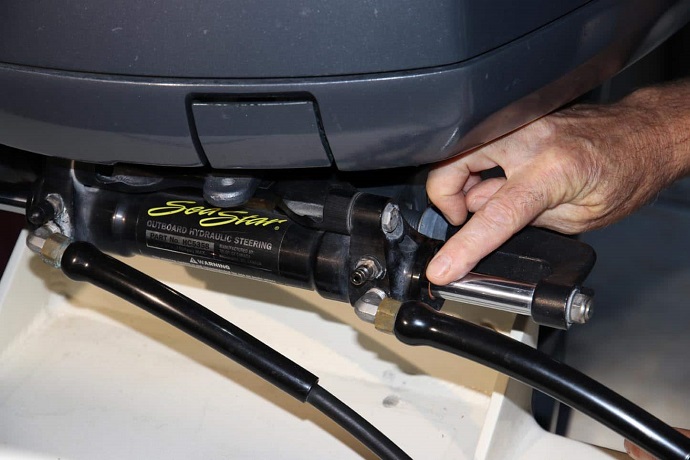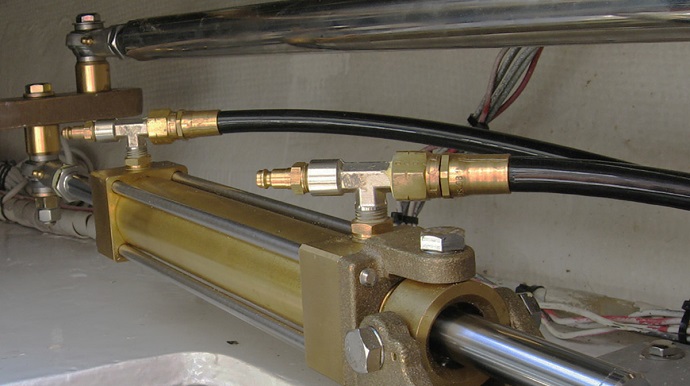Advantages of Hydraulic Steering Systems for Boats
Recreational boat owners are becoming increasingly aware of the benefits of upgrading their fidgety, cable-actuated steering systems with one of the new generations of reliable, low-maintenance hydraulic systems. They’re well worth the investment; but make no mistake: lower maintenance isn’t the only perk that hydraulic systems have to offer.
Their true purpose is to make steering easier and safer: advantages that aren’t always apparent until you’ve experienced just how much more in control of the boat you’ll feel once a hydraulic system’s installed. There’s a night and day difference between mechanical and hydraulic steering, especially if your boat’s been repowered and is producing more horsepower. Let’s take a look at what goes into a hydraulic upgrade, and why now might be the right time for you to consider making one.
Contents
Hydraulic Steering Systems Keep You Safe When You’re On the Water

Let’s be honest: one of the last things anyone ever wants to feel, whether it’s behind the wheel of a car or a boat, is that they’re not actually doing the steering. That’s precisely what happens, though, when your boat’s mechanical steering starts to stiffen or becomes increasingly unresponsive. New hydraulic steering for boat upgrade, however, is the solution you need to restore confidence in your steering. And if you’ve never operated a boat with hydraulic steering, you’re going to be amazed by how much more enjoyable your time on the water can be.
Although there are a number of high-quality upgrade options available, the operating principle behind every boat’s hydraulic steering system is the same: a helm-mounted pump that’s attached to the steering wheel pushes hydraulic fluid to a stern-mounted steering cylinder that points the engine(s) either to the port or starboard. If the system sounds simple, that’s because it is; and that’s also why they’re infinitely more reliable than mechanical systems.
Not counting the high-pressure hydraulic hoses, bulkhead fittings, and fasteners, an upgraded boat hydraulic steering system only consists of 3 components:
- A variable displacement steering pump and valve assembly that’s either forward-, tilted-, or rearward-mounted;
- A stern-mounted steering cylinder (ram) with valve assembly; and,
- Engine tie bars, specifically for 1 – 4 engine outboard configurations.
With hydraulic steering, boat owners don’t risk being handicapped by stubborn steering cables, or any other mechanical steering problems that could occur at the worst possible moment. Your boat stays safely and predictably under your control at all times, allowing you to keep your focus on other aspects of staying safe.
Upgrading to Hydraulic Steering Gives You More Control
Although being able to safely steer your boat needs to be the main reason for upgrading to a hydraulic steering system, it certainly isn’t the only one. Among the other advantages that an upgraded marine hydraulic steering kit has to offer include are:
- More precise steering. Because hydraulic steering systems are designed to maintain constant pressure on the steering cylinder, your steering is more stable when maneuvering or under acceleration.
- Less steering effort. The multiplying effect that hydraulic steering systems have not only allows the steering wheel to turn easier, but to rotate fewer times over to achieve the same turning radius.
- More responsive steering. With fewer moving parts than cable-actuated steering systems, hydraulic systems don’t experience widespread mechanical losses due to friction, allowing them to be more responsive.
While many of these upgraded characteristics would be admirable on their own, they’re especially favourable for longer and heavier boats that will inevitably be producing more horsepower. Boat owners can instantly notice how much lighter their steering feels, along with how quickly some of their classic steering maladies will also disappear.
Fixing Classic Steering Problems With a Hydraulic Upgrade

Even if you’re perfectly content with your boat’s steering feedback the way it is, there’s still a handful of classic steering events that mechanical steering systems simply don’t react well to, including:
- Excessive torque steer. This is your engine’s tendency to force the boat’s stern to gravitate in the same direction your propellers are rotating.
- Inexplicable steering bias. On the plane, this is your boat’s tendency to steer easier to port or starboard than it does in the reverse direction.
- Unmistakably heavy steering. While torque steer and steering bias both qualify and match this description, heavy steering that’s the result of too much power is unmistakably something different.
Redistributing weight, replacing worn mechanical parts, and frequent trim adjustments are all effective stopgaps, but upgrading your steering system from mechanical to hydraulic is the only comprehensive solution that’s engineered to actually remedy them all. And once you realize how much of a difference the upgrade makes, you’re not going to miss the cost or the maintenance routine that you’ve grown accustomed to with cable-actuated steering.
Maintenance Made Easier With a Hydraulic System

Let’s face it: no matter how well built they are, mechanical steering systems are a headache to maintain. Salt, dirt, and ordinary wear and tear all take an inevitable toll on steering cables, tilt tubes, and link arms; and depending on how much time you spend on the water, you may already be pulling (or replacing) cables, tilt tube cleaning, and re-greasing the entire mechanical assembly as many as three times a year.
With upgraded hydraulic steering systems though, you can effectively reduce your inspection and maintenance schedule to just one time every year or two. A fully-sealed hydraulic system’s lack of parts inherently simplifies the process, reducing your maintenance activities to just a handful of tasks that include:
- Topping off, or bleeding the system’s fluid;
- Cleaning and re-greasing the stern steering cylinder; and,
- Checking the condition of your hydraulic hoses and fittings.
Fewer moving parts means there’s less equipment to have a problem with, and a hydraulic upgrade is going to help keep your boat’s steering system as problem-free as it can possibly get.
The Final Word
At the end of the day, boat safety and maintenance go hand in hand. And while it’s natural to want to increase the former while decreasing the later, it’s not an easy compromise. Steering, however, is one of few systems on your boat where it’s not only possible, it’s actually preferable.
Upgraded hydraulic steering for the boat system is one of the best investments you can make in your boat’s safety, maintenance, and performance. You’re going to feel more confident than ever about how your boat steers, and your passengers will feel the difference too.






